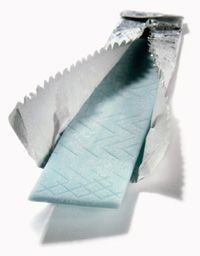Key Takeaways
- The myth that swallowed gum stays in your system for seven years is false.
- While gum isn't digested like other foods, it passes through the digestive system relatively quickly and is excreted.
- Swallowing gum occasionally is unlikely to cause any harm, but habitual swallowing could potentially lead to digestive issues.
Surely you were warned, most likely by your mother: You shouldn't swallow gum, because it stays in your digestive system for seven years. But if that were true, what kind of havoc would that wreak?
Our digestive system is built to dissolve and excrete what we put in our mouths in a matter of hours, days at most, but certainly not years.The urban legend reference Web site Snopes.com put the kibosh on the rumor that gum stays in you for years, and medical science confirms the site's conclusion. Pediatric gastroenterologist David Milov tells the magazine Scientific American that he can say "with complete certainty" that gum does not stay in you for seven years [source: Scientific American].
Advertisement
This is due to the effectiveness of your digestive system. When you swallow food, it travels down your esophagus into your stomach. Here enzymes and acids go to work on the food, beginning the process of breaking the food down.
From the stomach, the partially digested food is moved into the intestine, where -- with help from your liver and pancreas -- the food is broken down into its components. These components are used to fuel the body. Those elements of food that can't be used are sent to the colon, where they'll be processed into waste.
Generally, gum is made up of four general components, and our bodies can easily break down three of these. The gum's flavorings, sweeteners and softeners are all no match for human digestion. It's the gum base that sticks around. Gum base is made mostly of synthetic chemicals, and these chemicals give gum its chewy property. It's designed to resist the digestive properties of the saliva in your mouth. But once it's swallowed, even the gum base is subjected to the same treatment as regular food, and after it's recognized as useless by your digestive system, it goes the same route as any waste product.
Chewing gum began as early as 7,000 years ago -- researchers have found lumps of tar with human teeth marks in them. Modern gum got its start during the 1860s, when exiled Mexican general Antonio Lopez de Santa Anna (who captured the Alamo in March 1836) introduced chicle to gum maker Thomas Adams, who then made it into gum. But the origin of the gum-swallowing legend is much less clear. Despite the evidence lent by the continued healthy existence of those who swallow gum, this rumor persists. Perhaps that's because, every once in a blue moon, a medical case resulting from swallowed gum turns up.
David Milov and colleagues wrote in the journal Pediatrics about a few case studies of kids who had ignored admonishments against swallowing gum -- and paid for it. One boy suffered from two years of chronic constipation. Years of swallowing five to seven pieces of gum each day led to a "'taffy-like' trail of fecal material" consisting mostly of gum, which had to be suctioned out of his rectum [source: Milov].
But gum still doesn't stay in your digestive system for seven years. The boy who had the "'taffy-like' trail" was just 4 when he underwent the removal procedure. It's possible that the gum might have remained in his tract for seven years, but intervention by physicians circumvented that. So while he will always be a walking footnote in support of the fears of mothers everywhere, the seven-year mark remains elusive. And that's probably a good thing.
Advertisement


